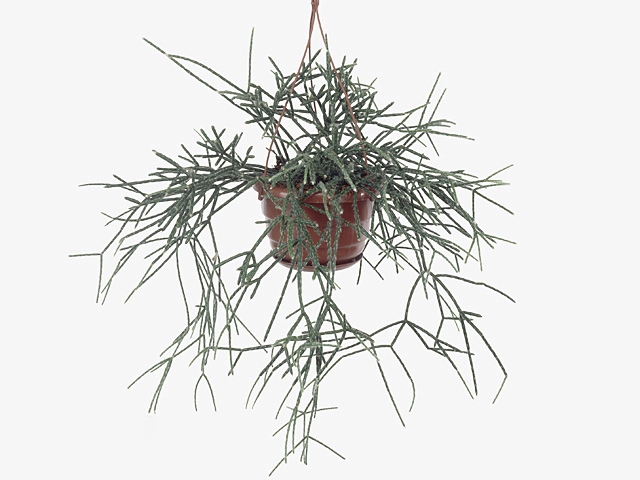Rhipsalis pilocarpa

| Fruit type | Berry |
| Structure (tissues) | Succulent |
| Plant, growth type | Pendulous |
Rhipsalis pilocarpa, commonly known as the Mistletoe Cactus, is a fascinating plant that belongs to the family Cactaceae. This unique cactus is native to the tropical rainforests of Brazil, where it thrives in the warm and humid conditions. What makes this species stand out from other cacti is its pendulous growth habit and succulent berry fruits.
The structure of Rhipsalis pilocarpa is truly intriguing. Unlike most cacti, which feature a more upright or columnar growth, this cactus grows in a pendulous manner, cascading down from its hanging position. The slender stems of Rhipsalis pilocarpa can reach lengths of up to 2 feet, and they are composed of fleshy, succulent tissues that give the plant a plump and healthy appearance.
One of the highlights of the Mistletoe Cactus is its berries. These small, round fruits are borne on the stem segments and give the plant a splash of color. The berries start off green but eventually mature into a vibrant red or purple hue, depending on the variety. They are succulent and juicy, making them a delight for both the eyes and the taste buds.
The berries of Rhipsalis pilocarpa are not only aesthetically pleasing but also play a crucial role in the plant's reproductive cycle. The bright colors attract birds and animals that consume the fruits, thus aiding in seed dispersal. Once the seeds are dispersed, they have the potential to germinate in suitable growing conditions, eventually giving rise to new Mistletoe Cactus plants.
Interestingly, the pendulous growth habit of Rhipsalis pilocarpa has evolved as an adaptation to its natural habitat. In the rainforests, this cactus grows as an epiphyte, which means it typically attaches itself to trees and grows on the trunks or branches. By hanging down from its perch, the Mistletoe Cactus maximizes its exposure to light, as it can receive sunlight from multiple angles.
Caring for a Rhipsalis pilocarpa requires providing it with the right conditions. These cacti prefer indirect light or filtered sunlight, as direct sunlight can scorch their delicate tissues. Being a tropical plant, they appreciate high humidity levels, so misting the plant occasionally can create the ideal environment. Additionally, well-draining soil and regular watering when the topsoil feels dry are essential for the plant's health.
In conclusion, the Mistletoe Cactus, Rhipsalis pilocarpa, is a captivating plant with its pendulous growth and succulent berry fruits. Its unique structure and adaptation to its natural habitat make it an incredibly versatile and visually appealing addition to any collection of cacti. If you are searching for a cactus with a twist, the Mistletoe Cactus might be the perfect choice.
Market availability index by month:
| Jan. | Feb. | Mar. | Apr. | May | Jun. | Jul. | Aug. | Sep. | Oct. | Nov. | Dec. |
|---|---|---|---|---|---|---|---|---|---|---|---|
| 4 | 3 | 3 | 3 | 3 | 3 | 3 | 3 | 3 | 3 | 3 | 3 |